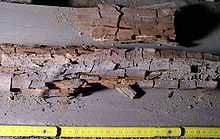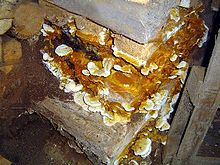
Back نخر جاف Arabic Suha truhlež BS Podriment sec Catalan Brunmuld Danish Braunfäule German Ξηρή σήψη Greek Desecamiento de la raíz Spanish پوسیدگی چوب Persian Pourriture cubique French Críonlobhadh Irish
This article needs additional citations for verification. (December 2016) |




Dry rot is wood decay caused by one of several species of fungi that digest parts of wood which give it strength and stiffness. It was previously used to describe any decay of cured wood in ships and buildings by a fungus which resulted in a darkly colored deteriorated and cracked condition.
The life-cycle of dry rot can be broken down into four main stages. Dry rot begins as a microscopic spore which, in high enough concentrations, can resemble a fine orange dust. If the spores are subjected to sufficient moisture, they will germinate and begin to grow fine white strands known as hyphae. As the hyphae grow they will eventually form a large mass known as mycelium. The final stage is a fruiting body which pumps new spores out into the surrounding air.
In other fields, the term has been applied to the decay of crop plants by fungi. In health and safety, the term is used to describe the deterioration of rubber, for example the cracking of rubber hoses.[1]
- ^ "Maintenance procedure for immersion suits and dry suits" (PDF). U.S.Coast guard. Retrieved 27 June 2017.